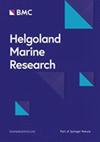Diversity of mangrove root-dwelling sponges in a tropical coastal ecosystem in the southern Gulf of Mexico region
4区 地球科学
Q2 Agricultural and Biological Sciences
引用次数: 1
Abstract
Sponges are one of the most conspicuous groups of epibionts in mangrove prop root habitats. However, with the exception of the Caribbean and the Indo-Pacific regions, studies focused on species diversity are lacking in other locations that have high mangrove coverage and are relatively distant from coral reef environments. Because mangrove-root epibiont communities, in general, have been understudied worldwide, this research contributes to filling this knowledge gap. In this study, a total of 30 sponge species (belonging to three subclasses, 14 families and 19 genera) were recorded as epibionts on prop roots of the red mangrove Rhizophora mangle in a tropical coastal ecosystem of the Southern Gulf of Mexico. Of these, five were new records for the Gulf of Mexico, 14 were new for the Mexican coasts of the gulf and 25 were new for the study area. Moreover, a similarity analysis based on presence/absence data of mangrove-associated sponges reported throughout the Western Central Atlantic region revealed that the sponge assemblage from the study area was more similar to those documented in most of the Caribbean locations (Jamaica, Cuba, Martinique, Panama, Venezuela, Belize and Colombia) rather than with those of the Northeast of the Gulf of Mexico, Guadeloupe and Trinidad. This relative intra-regional dissimilarity in the structure of mangrove-associated sponge assemblages may be related to differences in environmental conditions as well as taxonomic effort. The study area, unlike most of the Caribbean locations, is characterized by estuarine conditions and high productivity throughout the year. The inter-site variability recorded in the composition of mangrove-associated sponges was influenced by a set of factors such as salinity, dissolved oxygen and hydrodynamism. This study shows the importance of exploring the mangrove-associated sponge assemblages from different regions of the world as it furthers knowledge of the biodiversity and global distribution of this group.墨西哥湾南部地区热带沿海生态系统中红树林根栖海绵的多样性
海绵是红树林支柱根生境中最显著的表层生物之一。然而,除了加勒比海和印度洋-太平洋地区之外,在红树林覆盖率高且距离珊瑚礁环境相对较远的其他地区,缺乏对物种多样性的研究。由于红树林根系表面生物群落在全球范围内的研究不足,本研究有助于填补这一知识空白。本研究在墨西哥湾南部热带沿海生态系统中,记录了30种海绵作为红树根上的附生生物,隶属于3亚纲14科19属。其中,5个是墨西哥湾的新记录,14个是墨西哥湾沿岸的新记录,25个是研究区域的新记录。此外,基于整个大西洋中西部地区报告的红树林相关海绵的存在/缺失数据的相似性分析显示,研究区域的海绵组合与大多数加勒比地区(牙买加、古巴、马提尼克岛、巴拿马、委内瑞拉、伯利兹和哥伦比亚)的记录更相似,而不是与墨西哥湾东北部、瓜德罗普岛和特立尼达的记录更相似。这种与红树林相关的海绵组合结构的区域内相对差异可能与环境条件的差异以及分类努力有关。与加勒比地区的大多数地区不同,该研究地区的特点是河口条件和全年的高生产力。红树林相关海绵组成的点间变异受盐度、溶解氧和水动力等因素的影响。这项研究显示了探索来自世界不同地区的红树林相关海绵组合的重要性,因为它进一步了解了该群体的生物多样性和全球分布。
本文章由计算机程序翻译,如有差异,请以英文原文为准。
求助全文
约1分钟内获得全文
求助全文
来源期刊

Helgoland Marine Research
地学-海洋学
自引率
0.00%
发文量
0
审稿时长
6-12 weeks
期刊介绍:
Helgoland Marine Research is an open access, peer reviewed journal, publishing original research as well as reviews on all aspects of marine and brackish water ecosystems, with a focus on how organisms survive in, and interact with, their environment.
The aim of Helgoland Marine Research is to publish work with a regional focus, but with clear global implications, or vice versa; research with global emphasis and regional ramifications. We are particularly interested in contributions that further our general understanding of how marine ecosystems work, and that concentrate on species’ interactions.
 求助内容:
求助内容: 应助结果提醒方式:
应助结果提醒方式:


